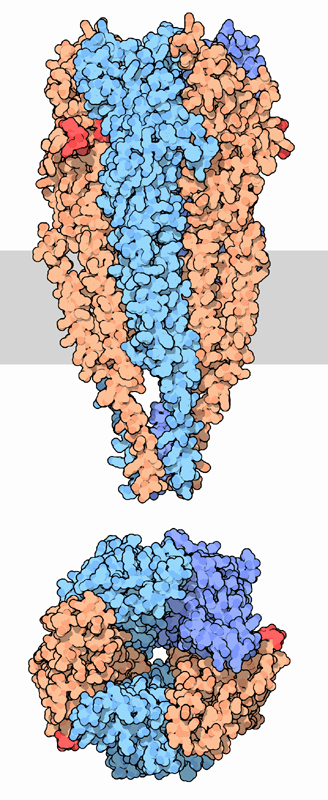|
Inhaltsübersicht | Nanomaschinen | Moleküle | Programme | Kurse | Fun | Links |
||
| > |
Acetylcholine Receptor

Acetylcholine Receptor
Nerve cells need to be able to send messages to each other quickly and clearly. One way that nerve cells communicate with their neighbors is by sending a burst of small neurotransmitter molecules. These molecules diffuse to the neighboring cell and bind to special receptor proteins in the cell surface. These receptors then open, allowing ions to flow inside. The process is fast because the small neurotransmitters, such as acetylcholine or serotonin, diffuse rapidly across the narrow synapse between the cells. The channels open in milliseconds, allowing ions to flood into the cell. Then, they close up just as fast, quickly terminating the message as the neurotransmitters separate and are removed from the synapse.The Cascade of Contraction
Acetylcholine receptors are found on the surface of muscle cells, concentrated in the synapse between nerve cells and muscle cells. A similar form is also found in the central nervous system, relaying messages from nerve to nerve (for more information on acetylcholine receptors from a genomics perspective, visit the Protein of the Month at the European Bioinformatics Institute). These acetylcholine receptors are composed of five protein chains, arranged in a long tube that crosses the cell membrane. Two of these chains, colored orange here, have binding sites for acetylcholine on the side, colored here in red. When acetylcholine binds to these two chains, the shape of the entire receptor changes slightly, opening the channel. This allows positively charged ions, such as sodium, potassium, and calcium, to cross the membrane. Muscles are constantly pumping sodium out of their cells, so when they are relaxed, there is more sodium outside than inside. When they get the signal from the nerve, however, the channels open and sodium ions to rush back inside, starting the process that will lead to muscle contraction.Biological Electricity
The acetylcholine receptor shown here (PDB entry 2bg9) is found in electric torpedo rays. It is a good subject for study because it is similar to the one found in our nerve-muscle synapses, and it is found in high concentrations in the electric organs of the ray. Electric rays and electric eels generate bursts of electricity with a special electric organ. It is composed of many modified muscle cells, which are flattened and stacked on top of one another. The small voltage differences across each cell membrane, controlled by the dense packing of many acetylcholine receptors, add up over the large stack, together producing a large electric shock that can stun their prey.Next: Cobras and Curare
Last changed by: A.Honegger,